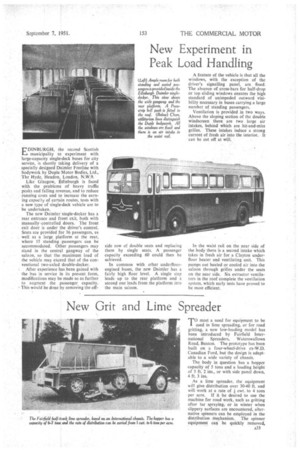New Experiment in Peak Load Handling
Page 55

If you've noticed an error in this article please click here to report it so we can fix it.
EDINBURGH, the second Scottish municipality to experiment with large-capacity single-deck buses for city service, is shortly taking delivery of a specially designed Daimler Freeline with bodywork by Duple Motor Bodies, Ltd„ The Hyde, Hendon, London, N.W.9.
Like Glasgow, Edinburgh is faced with the problems of heavy traffic peaks and falling revenue, and to reduce running costs and to increase the earning capacity of certain routes, tests with a new type of single-deck vehicle are to be undertaken.
The new Daimler single-decker has a rear entrance and front exit, both with manually-controlled doors. The front exit door is under the driver's control. Seats are provided for 36 passengers, as well as a large platform at the rear, where 15 standing passengers can be accommodated. Other passengers may stand in the central gangway of th.e saloon, so that the maximum load of the vehicle may eXceed that of the conventional two-axled double-decker.
After experience has been gained with the bus in service in its present form, modifications may be made so as further to augment the passenger capacity. k This would be done by removing the off,.
side row of double seats and replacing them by single seats. A passenger capacity exceeding 60 could then be achieved.
In common with other underfloorengined buses, the new Daimler has a fairly high floor level. A single step leads up to the rear platform and a second one leads from the platform into the main saloon. A feature of the vehicle is that all the windows, with the exception of the driver's signalling panel, are fixed. The absence of cross-bars for half-drop or top sliding windows ensures the high standard of unimpeded outward visibility necessary in buses carrying a large number of standing passengers.
Ventilation is provided in two ways. Above the sloping section of the double windscreen there, are two large air intakes, behind which are. hit-and-miss grilles. These intakes induce a strong current of fresh air into the. interior. It cari be cut off at will.
In the waist rail on the near side of the body there is a second intake which takes in fresh air for a Clayton underfloor heater and ventilating unit. This pumps out heated or cooled air into the saloon through grilles under the seats on the near side. Six extractor ventilators in the roof complete the ventilation system, which early tests have proved to be most efficient.
























































































